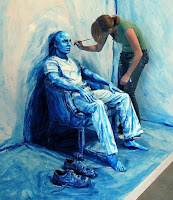If we step outside the box, and look away from the popular art materials that have been used over and over again, we'll find that art can be made with many of the common everyday objects as well. For example, instead of teaching kids how to paint objects, why not let them use the ones they have to create a painting? In the picture above, the artist reused the toy cars she had played with as a child to create an abstract piece of art. She was still able to focus on the different values of the colors, contrast, and design. By using a non-traditional medium, she was able to gain an appreciation of the materials she had and their characteristics, while using her creativity to bring them together in a cohesive manner.
 Taking a different approach in choosing your medium, also lets you convey a stronger message. Take the example to left. It was found on a website that supports endangered animals. For the artists, the main question was how to make a strong impression on their audience that would elicit care and action. Instead of painting the animals locked up in cages, or taking sad photographs of them, they took it a step further. they painted the endangered animals on large pebbles that they could hand out as paper weights. the animals appear crouched in a little space. That was the only way they could fit, and it conveys the message that endangered animals are being forced to uncomfortable lives in smaller habitats.
Taking a different approach in choosing your medium, also lets you convey a stronger message. Take the example to left. It was found on a website that supports endangered animals. For the artists, the main question was how to make a strong impression on their audience that would elicit care and action. Instead of painting the animals locked up in cages, or taking sad photographs of them, they took it a step further. they painted the endangered animals on large pebbles that they could hand out as paper weights. the animals appear crouched in a little space. That was the only way they could fit, and it conveys the message that endangered animals are being forced to uncomfortable lives in smaller habitats.Using unique art materials and objects, allows you to pursue the true focus of art ; creativity. It takes away the refined artistic lens, and lets you look at objects anew and wonder how you could use it to make art. Maybe you'll look at pensive person sitting, and instead of snapping their photo, you'll use them as your subject and paint over them for a 3-D effect. Or instead of teaching little kids how to draw pictures of their toys, you let them explore their options. Maybe they'll apply different colors of paint on their teddy bear and press it down on paper like a stamp! Or you can use old objects lying around the house, like rotary phones to create a sheep sculpture. What used to be the curly wire, now forms the fluffy body of the sheep, and the phone handle is the curved feet. In addition to creating unique art with new materials, you get to explore their form and structure and determine how it could enhance the 3-D effects of your artwork. Could you get all that at a typical art-store?





